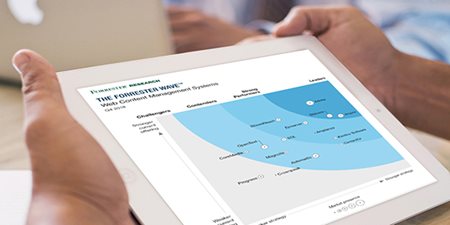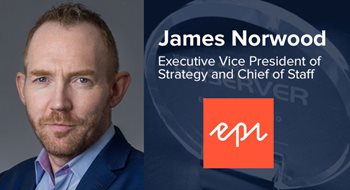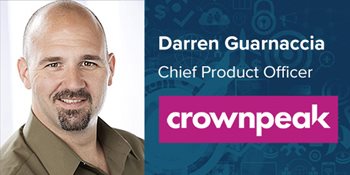Forrester Wave for WCMS 2018 Looks Into the Future
By Laura Myers
December 6, 2018
Acquia, BloomReach, content management, Content Management System, CoreMedia, CrownPeak, Episerver, Forrester, Magnolia, Progress, Progress Sitefinity, sitecore, Web Content Management, Website Accessibility
In mid-November, Forrester Analysts Mark Grannan, Allen Bonde and Madeline King authored the Forrester Wave: Web Content Management Systems, Q4 2018 and inside, we all got to see where the 15  most influential systems in the WCM market landed on the Wave. In the detailed report, we also hear Forresters’ thoughts on how each system stacks up with consideration to the needs of the market and, insight for decision-makers on how they can choose the best fit for their business.
most influential systems in the WCM market landed on the Wave. In the detailed report, we also hear Forresters’ thoughts on how each system stacks up with consideration to the needs of the market and, insight for decision-makers on how they can choose the best fit for their business.
Another attribute of the report for decision-makers is the breakdown of capabilities they need to keep top-of-mind during their evaluation process, all based on where the market is going and how the capabilities of a WCM can support that. As experience and agility emerge as the game-changers, customers need to know the system they choose will allow them to be proactive in keeping up with those demands. Forrester emphasizes things like microservices, how a system functions across channels, the flexibility of its APIs, the efficacy of its cloud offering etc.
These all lend to the massive benefit this report has to WCM vendors as well. Within is a wealth of information and a very pointed nature in establishing what customers need from a platform but also, the responsibility vendors have in not only providing these capabilities but educating customers on what they need to succeed. There is no obscurity in these analysts' evaluation of the platforms, making their strengths and weaknesses very clear and intelligible for their audience of both decision-makers and vendors.
Following the release of the report, I was able to speak with eight of the fifteen vendors in the report to hear their thoughts on their evaluation in the report and how those details would influence their business and platform goals for 2019. You will see them below, in the order of where they appeared in the report.
Acquia
Having recently attended Acquia Engage in November, I can attest to the momentum of change Forrester  mentions in their evaluation. 2018 for Acquia meant massive company growth, record sales and a tremendous investment in R&D. While we haven’t yet seen all the fruits of that labour, 2019 will hold the product enhancements many are anticipating from Acquia with many satisfying the needs of practitioners. As it stands, a feather in Acquia’s cap is its presence in government and higher education organizations given its strength in security and compliance. Generally speaking those digital teams are often more technology-driven, which lends itself true to Forrester’s comment that it is within that environment Acquia is a good fit.
mentions in their evaluation. 2018 for Acquia meant massive company growth, record sales and a tremendous investment in R&D. While we haven’t yet seen all the fruits of that labour, 2019 will hold the product enhancements many are anticipating from Acquia with many satisfying the needs of practitioners. As it stands, a feather in Acquia’s cap is its presence in government and higher education organizations given its strength in security and compliance. Generally speaking those digital teams are often more technology-driven, which lends itself true to Forrester’s comment that it is within that environment Acquia is a good fit.
In speaking with Matt Kaplan, SVP, Product at Acquia, he had this to say: “For the second time, Acquia has been positioned in the leader quadrant, demonstrating our continued strength in the marketplace. Specifically, Acquia received the highest strategy score among all vendors, as well as receiving 5s on a five-point scale for our vision, cloud, architecture, developer program and service partner program. Analyst reports like the Forrester Wave are important because they introduce Acquia to organizations that are planning large WCM deployments. We believe Forrester is right to emphasize the importance of flexible content architecture, APIs, improved analytics, and cross-channel delivery.
Reports like the Forrester Wave also help inform our product development priorities. In fact, we’ve entirely revamped the product experience with Acquia Lift, which we announced earlier this month at Acquia Engage 2018. This new release will be available in Q1 2019, and will feature:
- Guided step-by-step personalization
- A/B testing & targeting with no code
- Campaign-based scheduling
- Superior multi-lingual personalization
- Real-time dashboards”
Sitecore
This Fall, Gabriella and I also attended Sitecore Symposium 2018 and were privy to the excitement  surrounding their release of Sitecore v9.1. In hindsight, among other things, the release directly addressed a need highlighted in the report for web content management systems to better leverage the benefits of JavaScript.
surrounding their release of Sitecore v9.1. In hindsight, among other things, the release directly addressed a need highlighted in the report for web content management systems to better leverage the benefits of JavaScript.
Outsiders have also felt the winds of change within Sitecore in the last two years with their shift back to a focus on mid-market organizations and changes to leadership roles. In the summer of 2017, Mark Frost took the helm as CEO, nearly a year later in summer 2018, Paige O’ Neill took over as CMO and most recently, Ryan Donovan moved up to CTO in the last few months.
Ryan gave us his thoughts on Sitecore’s inclusion in the Forrester Wave here: “For sure, it’s a source of pride to be positioned in the Leaders segment of the Wave. We see it as an acknowledgement of all the hard work put in by everyone at Sitecore to earn the trust of our thousands of customers who ask us to deliver the breadth of capabilities they need to deliver a consistent, relevant, and valuable experience to their own customers. By extension, we also believe the Wave reflects why Sitecore experienced market-beating double-digit growth in the last year. Web content management doesn’t just continue to be a very vibrant product category—it’s the centerpiece around which companies are building their most strategic customer experience and digital transformation initiatives, and that fuels our drive to keep innovating at the edge of the market.
We’re leaning in to deliver an even more flexible, smarter, and efficient platform, with the launch of Sitecore JavaScript Services and our forthcoming next-generation content editing user experience as just a few examples. We’re also continuing to invest heavily in areas such as interoperability, analytics, cloud, and microservices, not to mention the ways our recent acquisition of Stylelabs will enable customers to own the entire lifecycle of managing their content from creation through distribution. All of this accrues to giving the modern marketer a unified platform that not only serves every corner of the customer experience, but also is easier to deploy, amazingly powerful and incredibly usable, and allows them to iterate more quickly and more often.”
Episerver
Our first event of 2018 was Episerver Ascend in March where announcements were made that, in a way  marked “the culmination of what we’ve been working on for a few years and it really helps to round out the personalization and analytics to provide the most value to our customers”, according to Episerver’s VP of Product Justin Anovick.
marked “the culmination of what we’ve been working on for a few years and it really helps to round out the personalization and analytics to provide the most value to our customers”, according to Episerver’s VP of Product Justin Anovick.
Following this, it is without a doubt that the next thing on Episerver’s to-do was to take this newly completed and rounded-out platform to market and for Episerver to grow their brand awareness, in North America especially. In September, we saw this addressed with the announcement of their agreement to be acquired by Insight Venture Partners at a valuation of USD $1.16 billion.
In the report, Forrester predicts this will also make Episerver more acquisitive themselves and they remain, as mentioned in other similar analyst reports, a great choice for organizations who have their eye on digital engagement that is at pace with marketing and eCommerce goals, as they are better there than served up as just a CMS.
James Norwood, EVP of Strategy and Chief of Staff at Episerver explains below what it means to him for Episerver to end an exciting year being featured, once again, in the Forrester Wave for WCMS: “First and foremost, Forrester is independent, balanced and their processes for evaluation are first-rate. They use the same criteria as benchmarks for each participating vendor, but even a less-than one-point overall difference can move vendors up/down, over/under because of the weighting of individual scores.
Episerver has earned its place among the most significant vendors in Forrester’s Wave for Web CMS, once again, by bringing together differentiating functionality with unmatched time-to-value. Collaborating, governing, individualizing, optimizing, personalizing, scaling, securing and testing content is uniquely core to Episerver with analyzing, verticalizing and visualizing content now reaching next-stage status.
We are proud to be included in the Wave and value Forrester’s due diligence. We’ll never stop supporting customers at each stage of their digital transformation through our own growth and with our strategic roadmap.”
When I asked how this placement would influence their strategy in 2019, he had this to say: “Content management is no longer solely about editing and publishing via the web channel but more about the experience end-users – whether they are shoppers or subscribers – have with that content based on who they are, what they are trying to accomplish. The beauty of Episerver is that we don’t just bring content, commerce and marketing into one screen, but we also help digital leaders move faster with increasingly broad channel support and app-like agility, meaning Web CMS users can take what they need, when and where they need it.
A large part of our customer community uses our CMS, and just one of the many ways we support them is through developer and partner education particularly as they begin to incorporate headless scenarios, single page and progressive web applications. While customers get the tools, they need to manage hyper-productive content out of the gate, we actively communicate the benefits of evolving to a more holistic and agile approach to the digital experience, which comes down to supporting rich content experiences across channels.
We’re transforming experiences by helping organizations become more digitally agile and with a Web CMS that starts and ends with individualized content and experience management. As stated in the research, Episerver has momentum and has grown at a quick pace over the last few years (most notably in North America) and we will continue to invest in our product to even better serve the needs of our customers and partners.”
BloomReach
BloomReach is yet another vendor who enjoyed a momentous 2018. With a few new members of the C- suite and a familiar face in the WCM landscape joining the team, Gabriella and I got to experience a refreshed BloomReach at their event in San Francisco a couple of months ago. Within the report, BloomReach is noted as being one of the more retail-centric platforms, which again, was obvious at their event and through their partnership announcement with strong eCommerce vendor, Elastic Path.
suite and a familiar face in the WCM landscape joining the team, Gabriella and I got to experience a refreshed BloomReach at their event in San Francisco a couple of months ago. Within the report, BloomReach is noted as being one of the more retail-centric platforms, which again, was obvious at their event and through their partnership announcement with strong eCommerce vendor, Elastic Path.
Their CEO, Raj De Datta, at the event and in conversation stated their strong position to empower those most pivotal within the Experience Era and draws a line in the sand between the old WCM and the new need for them to become a digital experience platform, aligning with one of Forrester’s requirements for WCM platforms as noted in the report.
Another new addition to the BloomReach team, John Field, Director of Product Marketing, had this to say about their inclusion in the Forrester Wave for WCM: “We at BloomReach are very proud of our achievement, especially in having the second highest placement on the "Current offering" axis, and the highest Architecture score, reflecting our investments in BloomReach Experience Manager over the last year. As we've already started investing in the areas that will improve the Strategy score, we're also very confident for the year ahead. Where the report calls out that "APIs, Content Analytics, and Cross-Channel Delivery are Key Differentiators" this is very much in line with our experience in the market and why we are seeing success with organizations who are making the transition to microservices and requiring the APIs and architecture to fit their vision. I'm personally also very much looking forward to discussing the Wave for WCM with Forrester Analyst Mark Grannan in our upcoming webinar on December 6th”
Magnolia
Magnolia represents a new addition to the Forrester Wave, joining other perennial players in the report.  Noted as a great fit for financial services companies, Magnolia recently made headlines with two exciting partnership announcements, Spryker and Siteimprove. It is noted in the report that version 6 shows a bigger shift to empower the marketing practitioner but overall, the platform remains a better fit for teams that are much more technology savvy. It is well-known that as time moves on, marketers are becoming more like technologists and tech teams are increasingly able to view growth through a marketing lens. In knowing this, Magnolia seems well-positioned for the WCM market ahead.
Noted as a great fit for financial services companies, Magnolia recently made headlines with two exciting partnership announcements, Spryker and Siteimprove. It is noted in the report that version 6 shows a bigger shift to empower the marketing practitioner but overall, the platform remains a better fit for teams that are much more technology savvy. It is well-known that as time moves on, marketers are becoming more like technologists and tech teams are increasingly able to view growth through a marketing lens. In knowing this, Magnolia seems well-positioned for the WCM market ahead.
Magnolia’s CMO, Rasmus Skjoldan gave us his exclusive commentary on their new position in the report: “We see our new position in the Wave as a solid confirmation that our product vision and strategy are on the right track to meet the needs and aspirations of a modern digital leader. We’ve invested heavily to enable more and more capabilities that modern digital experiences require: Speed, frontend technologies, usability and great connectivity to adjacent tools in the marketers’ stack are the pivotal prerequisites for improving the customer experience. The Forrester report says: “[Magnolia’s] broader strategy is shifting heavily to embrace the marketing practitioner as version 6 promises a redesign focusing on drastic simplification in addition to lofty ambitions for AI/ML, CI/CD and content hub capabilities.
We are thrilled to see this as we near the release of the new Magnolia 6, going out this year. Our new version is designed as a radical rethink of our well-known enterprise content management platform. Magnolia 6 comes with a new UI that is modern and fresh and leaves ample room for integration of data from other sources - whether it’s other content sources, analytics or e-commerce platforms. We want to give businesses an extraordinary experience platform, an intelligent content hub, and greater potential to create value across the entire customer life cycle. We’re committed to enabling seamless and meaningful interoperability across our CMS and any connected tool - and our 2019 strategy continues on this path.”
CoreMedia
CoreMedia is a vendor who is really putting content and commerce in the driver’s seat for their overall  platform strategy with their focus set on building out their market presence in North America. They also match up well with the requirements of WCM platforms to have open and flexible APIs as they understand the need for every experience, from the micro to the macro, needs to function well across all channels. CoreMedia also heeds Forrester’s advice on the need to improve their partner ecosystem and as such, have a great many key technology partner relationships to nurture as time moves on.
platform strategy with their focus set on building out their market presence in North America. They also match up well with the requirements of WCM platforms to have open and flexible APIs as they understand the need for every experience, from the micro to the macro, needs to function well across all channels. CoreMedia also heeds Forrester’s advice on the need to improve their partner ecosystem and as such, have a great many key technology partner relationships to nurture as time moves on.
CoreMedia’s CEO and Co-Founder Sören Stamer shares what their inclusion in the Forrester Wave means to them: "We are excited to be included in Forrester’s newest Wave for Web CMS. It’s a first for CoreMedia Content Cloud. And that’s a reason to celebrate.
It is great to see, that our strategy to deliver 'The Best CMS for Commerce' is finally recognized by Forrester. As usual, analyst reports are a somewhat lagging indicator here. Truth is, that CoreMedia quietly became the market leader for luxury e-commerce platforms globally. Many leading fashion brands orchestrate more iconic experiences for global drops, at much faster speed and larger scale than ever before with CoreMedia Content Cloud.
The same can be said with regard to our cloud offering. We see very strong adoption of CoreMedia Content Cloud Service within the last 6 months with customers mastering global rollouts in dozens of markets in just a few weeks. As Forrester pointed out, speed and agility of cloud offerings are strategic benefits for us and our customers. So we will double down on our strategy to provide 'The Best CMS for Commerce in The Cloud'.
Overall, Forrester’s list of key capabilities are a good reference. Following our open best-of-breed strategy, we’re pushing hard to empower customers to leverage their existing infrastructure and even more best-of-breed components. Open APIs and the ability to deliver iconic micro-experiences to a “myriad of channels” have always been key pillars of CoreMedia’s success.
Our global brand customers thrive to stand out with iconic personalized experiences that integrate all touchpoints in 30+ languages and 100+ countries. The complexity of global drops at this scale is staggering. With that in mind, we are convinced that two crucial aspects are missing in the report. Customers should add the following two key requirement to their content management infrastructure:
1) Business Logic Layer to integrate Content, Context & Commerce. In order to build iconic personalized experiences, companies need to dynamically integrate content with various context sources and transactional commerce capabilities. The trend to headless commerce and micro-service architectures supports more flexibility but it also creates new challenges. Companies need to avoid redundant business logic if they want to create seamless multi-touchpoint experiences. That’s why CoreMedia customers love our business logic layer and our object-oriented content and experience model.
Selecting the right image with the right crop and resolution for a french speaker in Indonesia on a rainy day who has bought multiple fashion pieces in the past and uses a new iPhone XS Max is the name of the game. The complexity of global multi-touchpoint campaigns is still not appreciated enough. Most headless content management solutions and many others don’t offer support here at all. That’s where CoreMedia shines.
2) Experience Orchestration for Practitioners to Master the Complexity of Global Experiences. The second area that makes a fundamental difference for our clients is the ability for marketing and merchandising practitioners to create, preview and orchestrate personalized experiences at global scale without relying on the IT department of external agencies. Surprisingly, this aspect doesn’t receive much attention by Forrester yet. Based on the feedback from our customers and prospects, that will likely change in the future.
We strongly believe that an Experience Orchestration Tool for practitioners provides key capabilities for marketing departments to achieve the level of control they need. Headless architectures make that requirement even more pressing. Without the ability to preview global experiences in real time for different markets, devices, segments, times of day or even at any time in the future, marketeers fail to deliver the iconic quality they aim for.
We plan to incorporate Forrester’s feedback with regard to transparency and partner support into our strategy in 2019. Therefore, we will foster our partnerships with Salesforce, SAP, IBM, ElaticPath, Spryker, Commercetools plus their ecosystem partners.
The future of Content Management is about much more than the web and content. It’s about iconic personalized experiences at scale in an open, ever evolving ecosystem. That’s what we are developing for. In this light, the name 'Web CMS' seems more anachronistic every day while Content Management is more strategic than ever.
In other words: Content matters. It’s all about the experience. Be iconic."
Crownpeak
Throughout the last year, Crownpeak has made an effort to focus on governance and digital quality  management and with good reason, such regulations as the GDPR came into effect with likely more on their way. This is noted in the Crownpeak’s evaluation in the Forrester Wave and it is said their focus on customer data privacy allows for “respectful” experiences. This is also timely considering a lot of the most impactful literature on the GDPR focuses on gaining the attention of marketers and with Crownpeak being a very governance focused platform aimed at empowering marketers more than developers, it’s bringing two previously disparate notions together at a crucial time.
management and with good reason, such regulations as the GDPR came into effect with likely more on their way. This is noted in the Crownpeak’s evaluation in the Forrester Wave and it is said their focus on customer data privacy allows for “respectful” experiences. This is also timely considering a lot of the most impactful literature on the GDPR focuses on gaining the attention of marketers and with Crownpeak being a very governance focused platform aimed at empowering marketers more than developers, it’s bringing two previously disparate notions together at a crucial time.
Their well-known status as a pioneer in the cloud space sets them apart and just so happens to also recruit team members, one of which being their new Chief Product Officer Darren Guarnaccia, who also shared his thoughts on Crownpeak’s inclusion: “It's interesting to see the different positions that analysts take when it comes to marketing technology. Whereas Forrester's current POV is that suite approaches are the most valued, our opinion in this case is that marketers take a more selective approach.
At Crownpeak, we have intentionally focused on not locking customers into an end-to-end suite approach. We believe you should be free to use best-in-class technology for every piece of your martech stack and your CMS should not lock you into a certain eco-system. This allows you to integrate with cutting-edge tech and move with the agility required of a modern marketer. We're focused on fast time to value, the unique scalability and agility that comes from being a native SaaS CMS, and providing the foundation that marketers need to produce effective digital experiences. We think this is what is of most importance to marketers.“
Progress
In May of this year, Gabriella and I were in Boston to attend ProgressNEXT 2018 where their focus was  aimed at really ensuring experiences were both adaptive and seamless across channels while the platform itself maintained a high level of cognitive efficacy in its nature of being smart and self-learning. To align with both of these initatives, there were two key product announcements at the event. The first being DataRPM Self Service, which “with Amazon web services they will now offer the industry’s first industrial IoT self-service option for anomaly detection and prediction using cognitive machine learning” and the second was Progress Sitefinity version 11, which is hinged on delivering engaging web experiences through a heightened productivity allowed for marketers and developers.
aimed at really ensuring experiences were both adaptive and seamless across channels while the platform itself maintained a high level of cognitive efficacy in its nature of being smart and self-learning. To align with both of these initatives, there were two key product announcements at the event. The first being DataRPM Self Service, which “with Amazon web services they will now offer the industry’s first industrial IoT self-service option for anomaly detection and prediction using cognitive machine learning” and the second was Progress Sitefinity version 11, which is hinged on delivering engaging web experiences through a heightened productivity allowed for marketers and developers.
Overall, we’re hearing a lot about how touchpoints will increase exponentially over the next couple of years and in the WCM market, Forrester notes this as one of the more important considerations when choosing a system, how does a systems’ APIs support effective content delivery? At the event we interviewed Dion Picco, VP of Product Management and UX at Progress Sitefinity and he stood firm on that fact that content management systems can’t just be designed for the web but must be “designed to provide API access to your content so that any of those devices can both fetch content and report analytics that ultimately allows you to have consistency of delivery but more importantly harmonize and analyze customer journeys and customer experiences across all of those channels”.
Dion was also able to share his thoughts on their position within the Forrester wave: “The Forrester Wave WCM report this year unfortunately missed the mark in terms of its connection to actual customer experiences with the products and real world feedback from users.
The most accurate source of information on any product, as we all know as consumers in 2018, is actual user reviews. When customer reviews are incorporated at volume, they provide critical and accurate insights into a product’s strengths and weaknesses. Analyst firms that incorporate user-generated reviews in their analyses tend to be much more impartial and accurate in their evaluations than those that are written by one industry analyst based on vendor-contributed information alone. No single analyst knows more about a product than all of the users of that product put together.
A great resource for customer evaluations of WCM products, can be found in the Gartner Peer Insights report. Gartner offers an open platform for customers to self-report and rate their own experiences with the WCM systems they use. On Gartner Peer Insights, for example, Progress Sitefinity received 4.3 out of 5 stars from 160 verified customer reviews – more than any other vendor in the WCM category. This is a rating that I think buyers and the outside world can take seriously. Other peer review sites like G2Crowd are also valuable resources.
We believe responsible industry analysts should seek out peer reviews on the products they cover, and avoid making independent determinations that can be skewed by pre-conceived biases or vendor relationships.”

Laura Myers
A digital business, marketing and social media enthusiast, Laura thrives on asking unique, insightful questions to ignite conversation. At an event or remotely, she enjoys any opportunity to connect with like-minded people in the industry.